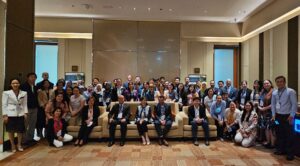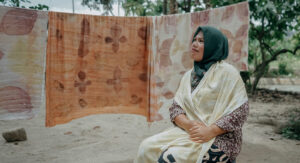Message of ACB Executive Director Dr.Theresa Mundita Lim during the ACB & Manila Observatory Partnership Launch
2 October 2023
To the honourable Secretary of the Department of Environment and Natural Resources and former Executive Director of Manila Observatory, Secretary Maria Antonia Yulo-Loyzaga,\
Fr. Jose Ramon T. Villarin, S.J.
Executive Director of Manila Observatory,
Dr. Antonio La Viña, Corporate Secretary of the Board of Trustees of Manila Observatory, Associate Director for Climate Policy and International Relations, and current Head of its Klima Center,
And to all our allies in communicating biodiversity and climate change, our media partners,
Good morning!
In 2010, a friend of mine did their field work in Palanan, Isabela after Typhoon Megi, one of the strongest typhoons that year, hit the northeastern part of Luzon. He took several photos of the destruction. A month later, my friend, Leonard Co passed away, and a year after, his brother-in-law, Darwin Flores trekked back to Palanan to honour Leonard’s legacy. What Darwin saw was a recovering ecosystem, beginning to teem with life and diversity. The forest could not have been restored by humans, as the area was not easily accessible by land.
It was thus concluded that it was the wildlife that took shelter in the least affected part of the Sierra Madre that were responsible for the replanting and regeneration.
This story, I thought, was a good example of how climate change and biodiversity are intertwined. Climate change impacted the biodiversity of Sierra Madre, but healthy biodiversity also recovers easily and so provides the function of resiliency.
Moreover, with these shared ecosystem goods and services, The ASEAN region can leverage the cooperation among its member states for its socio-economic development.
Biological diversity is not just diversity in species but also in ecosystems. While we are fortunate to be enjoying this natural wealth, the ASEAN region is beset by the worsening impacts of climate change. Every year, we are seeing how the series of typhoons can exact a heavy toll on human lives, livelihoods, and economies.
Southeast Asia remains one of the vulnerable regions, being among the most disaster-prone in the world, with 1,218 disasters occurring from 2012 to 2018, data from the ASEAN show.
Data from the World Meteorological Organization, in its Global Annual to Decadal Climate Update Target years: 2023 and 2023-2027 says:
- The chance of at least one year between 2023 and 2027 exceeding the warmest year on record, 2016, is very likely (98%).
- The chance of the five-year mean for 2023-2027 being higher than the last five years (2018-2022) is also very likely (98%).
- The chance of global near-surface temperature exceeding 1.5°C above pre industrial levels for at least one year between 2023 and 2027 is more likely than not (66%).
- The El Niño Southern Oscillation (ENSO) is predicted to most likely be positive in December to February 2023/24.
Climate change is one of the main drivers of biodiversity loss. Because of the range of temperatures that different species can withstand, species and ecosystems have evolved to flourish in particular environments. Due to the continued rise in temperature brought by climate change, some species that could not migrate or adapt to this drastic temperature rise may go extinct.
Species loss, on the other hand, reduces our natural defense against the detrimental impacts of climate change.
Climate change and biodiversity loss are part of the triple planetary crises. Both concerns should be tackled together since they both pose a threat to our basic survival.
While climate change is one of the drivers of biodiversity loss, biodiversity, through protection, ecosystem restoration and conservation, are nature-based solutions that are a crucial part of climate action.
The Kunming-Montreal Global Biodiversity Framework (KM GBF) recognises the need for climate change mitigation and adaptation. Target 8 of the KMGBF says:
Minimise the impact of climate change and ocean acidification on biodiversity and increase its resilience through mitigation, adaptation, and disaster risk reduction actions, including through nature-based solution and/or ecosystem-based approaches, while minimising negative and fostering positive impacts of climate action on biodiversity.
In addition, the ASEAN Leaders during the 43rd ASEAN Summit in Jakarta, Indonesia expressed the importance of promoting nature-based solutions to protect biodiversity as a post-pandemic recovery and enhance the resilience of the ASEAN region against zoonotic diseases, addressing climate change, and facilitating regional contributions to the KM GBF.
The diversity of ecosystems found in the ASEAN all serve as various layers of protection against climate change impacts. Mangrove ecosystems have been widely promoted as natural buffers against storm surges, and indeed it is. The region is also composed of a variety of coastal and marine ecosystems, such as beach forests, seagrass beds and tidal flats, not to mention near shore coral reefs that act together as systems of natural break waters against large and strong sea waves.
Healthy coral reefs can absorb up to 97 percent of a wave’s energy, buffering coastal communities from storms and associated waves, flooding, and erosion.
Wetlands such as marshes and mangroves protect coastlines by dampening storm surge and waves; they also prevent erosion and can build new land.
Ocean habitats such as seagrasses and mangroves can also sequester carbon dioxide from the atmosphere at rates up to four times higher than terrestrial forests can. Their ability to capture and store carbon make mangroves highly valuable in the fight against climate change.
Almost 2 million square kilometers of lakes, rivers, freshwater swamps, marshes, streams, and other inland waters and wetlands can be found in the ASEAN region. Out of the region’s 57 ASEAN Heritage Parks (AHP), 9 are wetlands, occupying approximately 684,000 hectares. Wetlands are known to be the most effective carbon sinks on the planet, storing twice as much carbon as all the forests.
The ASEAN has at least 12 forest types which serve different functions, some like pygmy forests serve better in areas vulnerable to strong winds, while forests with large dipterocarps are effective in absorbing large amounts of rainfall to help prevent sudden rise of water level in flood-prone areas.
Species diversity in trees and wildlife is also key to more resilient ecosystems, and the genetic diversity in wild foods can be valuable sources of disease-resistant and pest-resistant protein and have valuable potential for food productivity.
The ASEAN region is rich in biological resources and natural heritage. We have 25 percent of all known plants and animals species despite only possessing 3 per cent of the world’s land area. The species endemic to the ASEAN region is 37 per cent. We also have a vast shoreline of 173,000 km.
Three of the ten countries are considered megadiverse countries, five are part of the Indo-Burma Region, which is considered one of the wealthiest regions in the world, in terms of biodiversity. Singapore is globally known for its sustainable, green city that has allowed a rich variety of wildlife to thrive and survive within an urban setting. And a large part of Brunei, and portions of Indonesia, and Malaysia are what is known to be among the world’s key centres of biological diversity, the heart of Borneo. These vast resources contribute to the basic needs– such as food, water, clean air, and resilience against natural disasters — of 661.5 million people of the ASEAN region.
Moreover, unusual observations in wild species in their natural habitats can be natural early warning systems, before impacts on human populations can be felt. Unique characteristics and behaviour in nature can also serve as inspiration for technology and innovations.
All these can be described as solutions based on nature or what most call as nature-based solutions. It should be clear though that the way we use the term refers to the actions that work with and enhance nature to help address societal challenges and that the concept is grounded in the knowledge that healthy natural and managed ecosystems produce a diverse range of services on which human well being depends.
The example that I have given earlier, in the Sierra Madre Mountains, is a good example of a nature-based solution to the impacts of climate change. It is one of the most important protected area systems in the Philippines’ eastern seaboard that serve as our natural shield against extreme weather conditions.
Protected areas are at the core of these nature-based solutions. Healthy ecosystems are more resilient to climate change. Ecosystems contribute to climate solutions. Pristine marine and terrestrial areas serve as carbon sinks. Mangroves, apart from its many services, cushion the impacts of storm surges and strong waves.
Currently, the ACB is supporting the conservation and management of protected areas through its ASEAN Heritage Parks (AHP) programme, a flagship program of the Centre which enhances the protection and capacity building of protected area managers, staff, and park rangers in both terrestrial, marine and wetland ecosystems. To date, there are 57 declared AHPs in the ASEAN region.
In the Philippines, the Protected Area Management Board of Mount Apo Natural Park has involved the local tribe of Bagobo-Tagabawa in forest conservation activities.
Mt. Apo Geothermal Power Plant operates within the Mt. Apo National Park, one of the ASEAN Heritage Parks in the Philippines. It provides cheap, clean and stable power to meet the economic growth of Mindanao while providing payment for ecosystem services to the indigenous tribal groups and carrying out reforestation efforts to ensure that watershed protection that sustains the steam that powers the geothermal energy in addition, The same watershed is habitat to the endemic Philippine eagle, and all the other species associated with it.
In Indonesia, the collaborative management of Kepulauan Seribu National Park was instrumental in local empowerment. Coastal communities became vanguards of marine biodiversity, particularly the coral reefs and sea turtles. This was made possible through the Kampung Iklim (Proklim) which also provided income opportunities to local communities through ecotourism and mangrove conservation projects.
The case of Bukit Timah Nature Reserve and Sungei Buloh Wetland Reserve in Singapore demonstrates a case of ecosystem restoration, through ANR. In addition to the serious and sustained reforestation efforts of the local communities, the National Parks Board (NParks) of Singapore closed the park for two years (2014-2016) to allow natural regrowth. They conducted a study by comparing the data before and after the closure. The results showed forest recovery and improvement in soil conditions. Both nature parks are recognised as NBS to “cushion the impact of urbanisation and mitigate the effects of climate change.”
The ACB recognises assisted natural regeneration or ANR as an effective NBS, thus, to complement natural forest recovery, the ACB implements the ASEAN Green Initiative (AGI), a 10-year campaign for ecological restoration in the region. It is the first region-wide native tree planting programme aiming to plant 10 million trees across the 10 AMS for a period of 10 years.
The programme puts emphasis on native tree species for planting since they are likely to survive in their natural environment and are more sustainable in the long term. Native trees are well adapted to the climate and soil, hence they are more resilient and have a higher rate of survival.
Planting and growing native trees could enrich biodiversity and help revive the natural interactions between organisms and species of both flora and fauna.
In the “Natural Climate Solutions hierarchy”, protecting intact ecosystems has the highest potential for mitigation, followed by management of working lands, and lastly restoration.
Preventing the loss of stored carbon by protecting ecosystems is estimated to be about twice as effective globally as restoring lost or damaged ecosystems (around 4 GT CO2 per year compared to 2 GT CO2 per year for restoration).
Moreover, the gradual accumulation of carbon from restoration cannot compensate, in a timely way, for the rapid emission of large amounts of carbon from deforestation and degradation.
Protecting intact ecosystems, especially old-growth forests, also brings the greatest benefits for biodiversity and local communities (including supporting climate change adaptation) and has the lowest risk of impermanence.
Last year in Montreal at the CBD COP 15, in my conversation with Sec Yulo about downscaling global data that will be useful for enhancing NBS and ecosystem-based adaptation at the regional level, she brought our attention to CORDEX and the work of the Manila Observatory. Today, we begin to make things happen.
Through our partnership with Manila Observatory, we aim to demonstrate through modelling and visualisation, the inextricable link between climate change and biodiversity. We want to provide a platform to harmonise efforts, exchange knowledge, and build capacity of practitioners so as to contribute to the achievement of both regional and global biodiversity and climate targets. And, we hope to come up with evidence-based information that will help us effectively and sustainably harness our God-given natural wealth, our rich and unique biodiversity in the Philippines and, in the ASEAN, to protect us from the adverse and increasing effects of a warming planet.
























